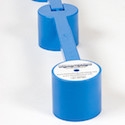As stated in the above video,when choosing a stick, try to find one that goes up about to your chin. Most players don’t go much higher than the nose, or much lower than the throat. A stick can always be cut shorter, but keep in mind cutting your stick will change the flex. For taller players, a plug can be added to the end of the stick, but this will also have an affect on the flex and balance. It’s best to choose a stick that is the correct length in the first place if possible.
When playing defense, a longer stick is nice because it gives the player more reach. Forwards sometimes prefer a stick that is shorter because it allows them to keep the puck closer to the body thus improving control. A stick that is too long will cause the elbow to become parallel to the ground making it more difficult to maneuver. Puck handling should be mostly done by rotating the wrists, and power comes from the legs, hips, and shoulders—not the elbow. Finally, as stated in part I, experiment until you find something that feels comfortable.
Coming up next: Hockey stick blade patterns
Tags: stick






Hi!!
How do you measure the lenght of your stick? Do you measure the lenght when the stick is in 90° with the ground and you take the lenght from the ground to the top of your stick?
Thanks
I put the butt on the ground then see where the top of the blade slaps me in the face.
[…] you buy your first expensive stick be sure to read our three part series covering stick flex, stick length, andblade […]